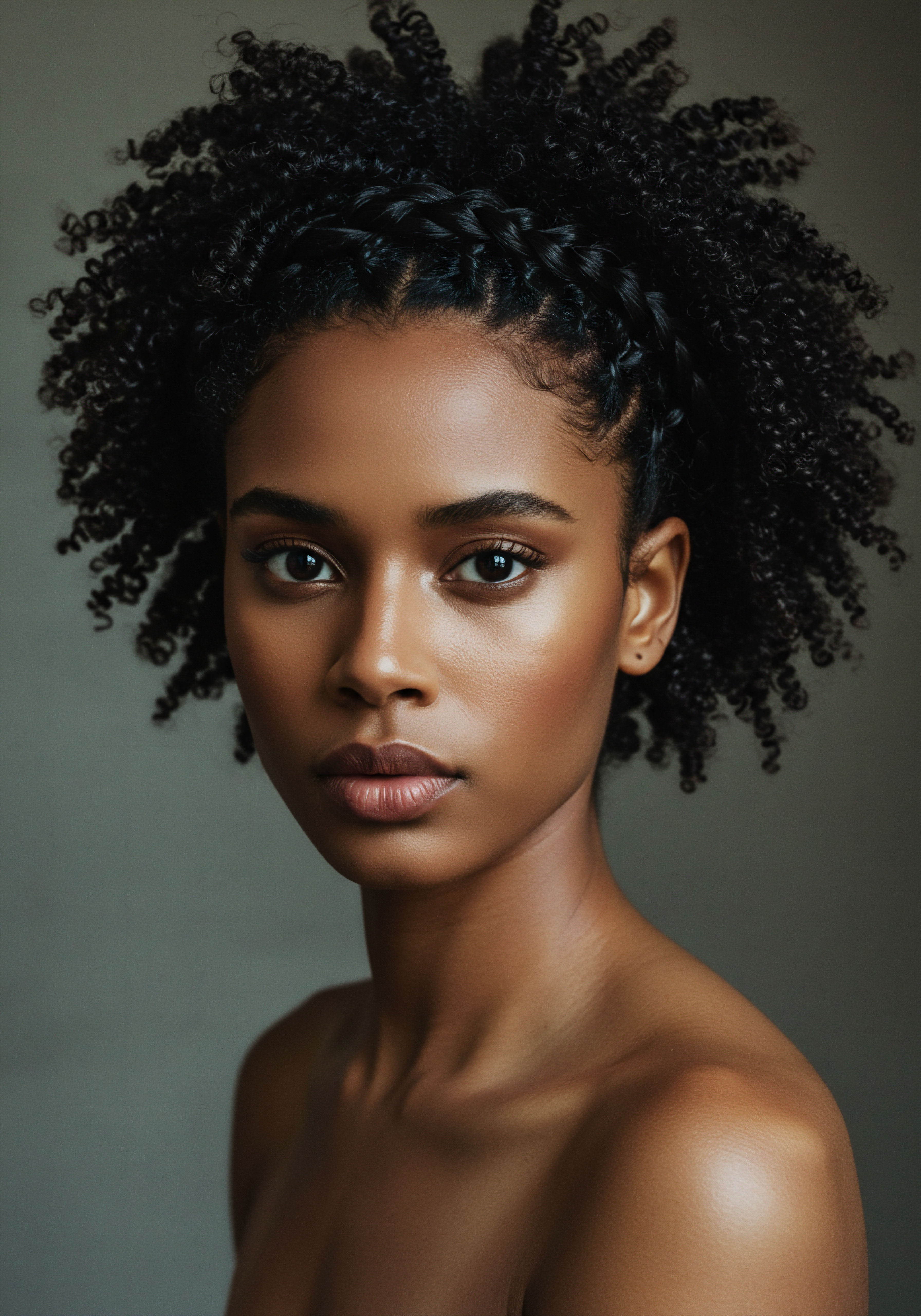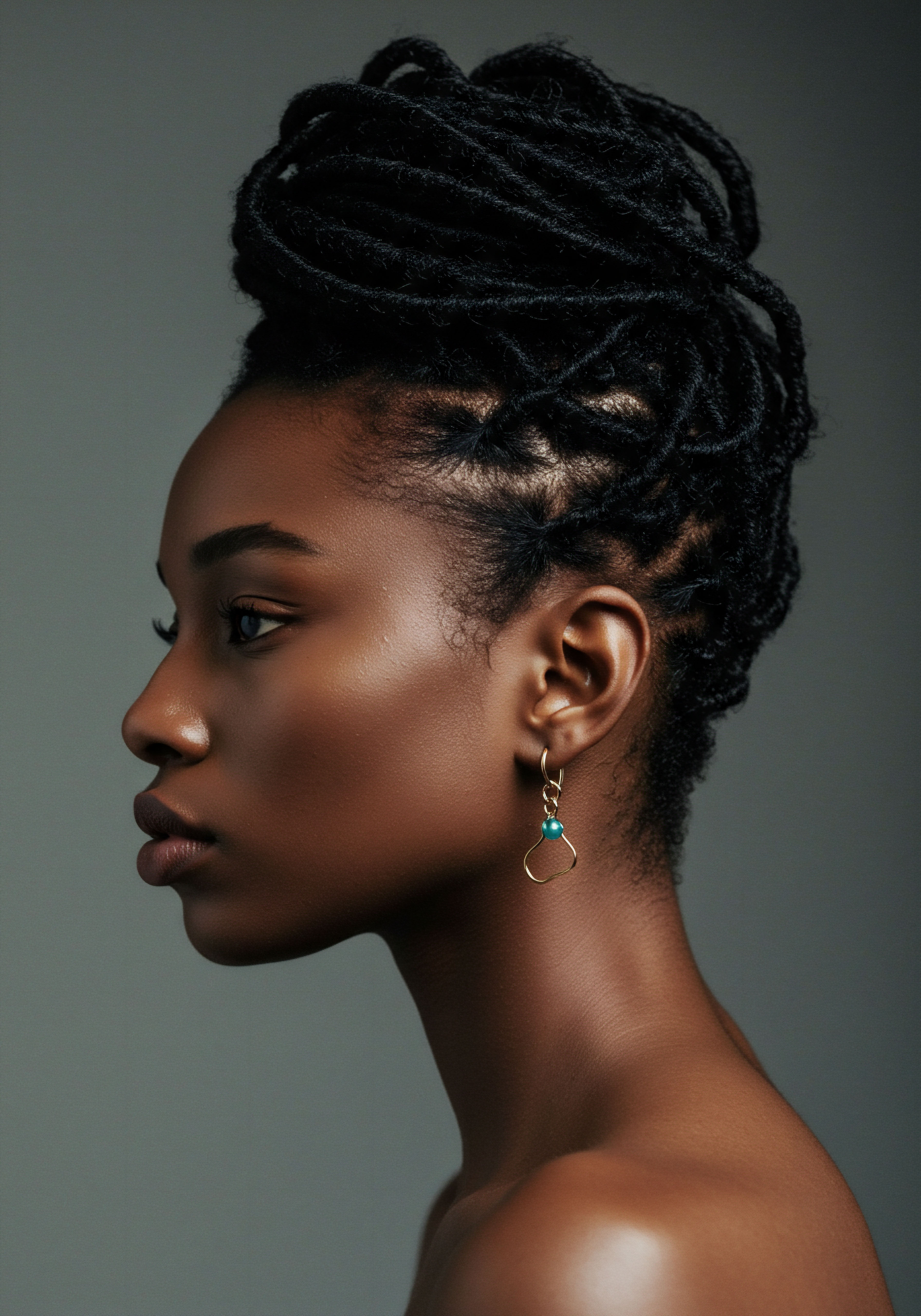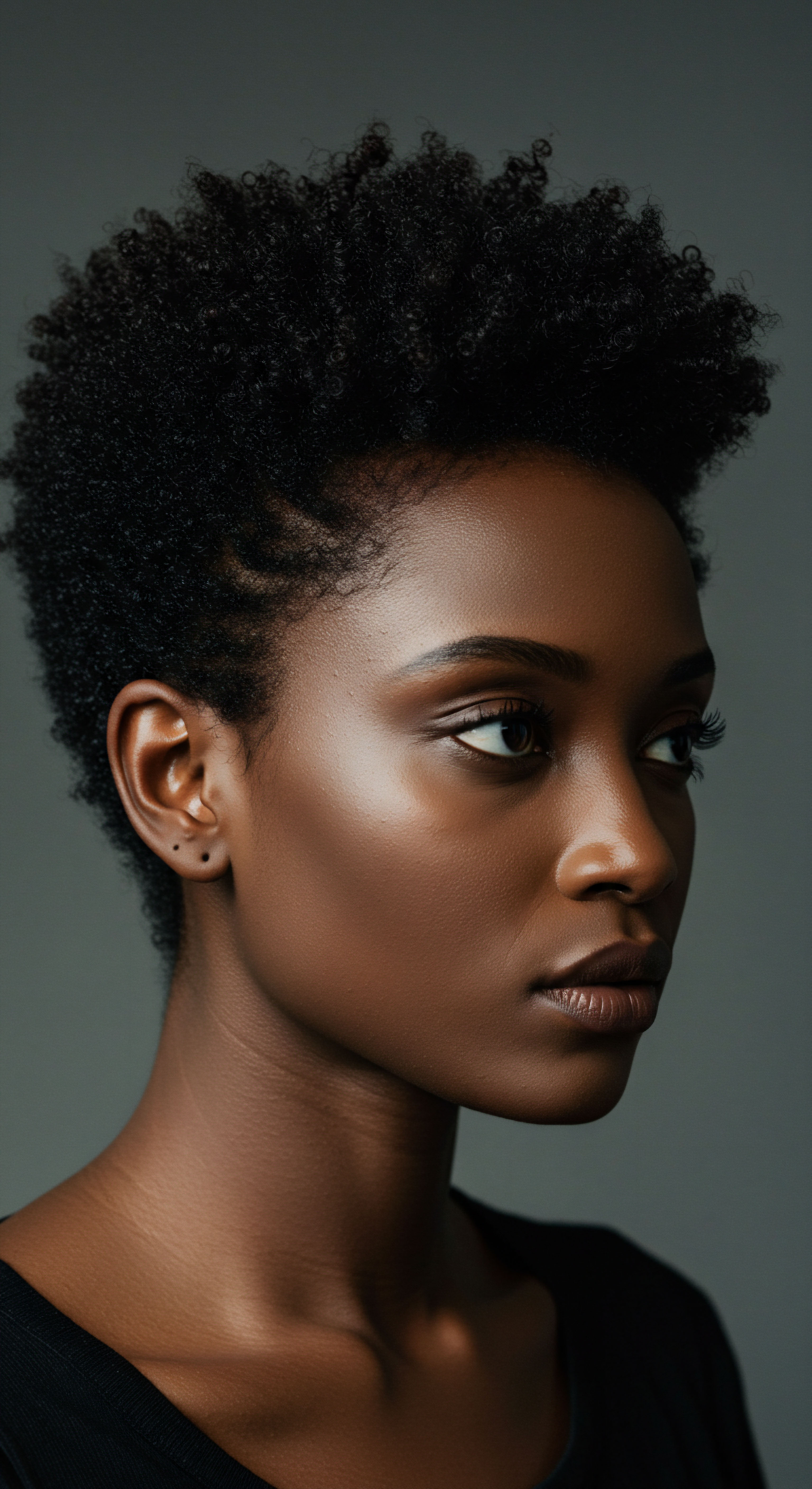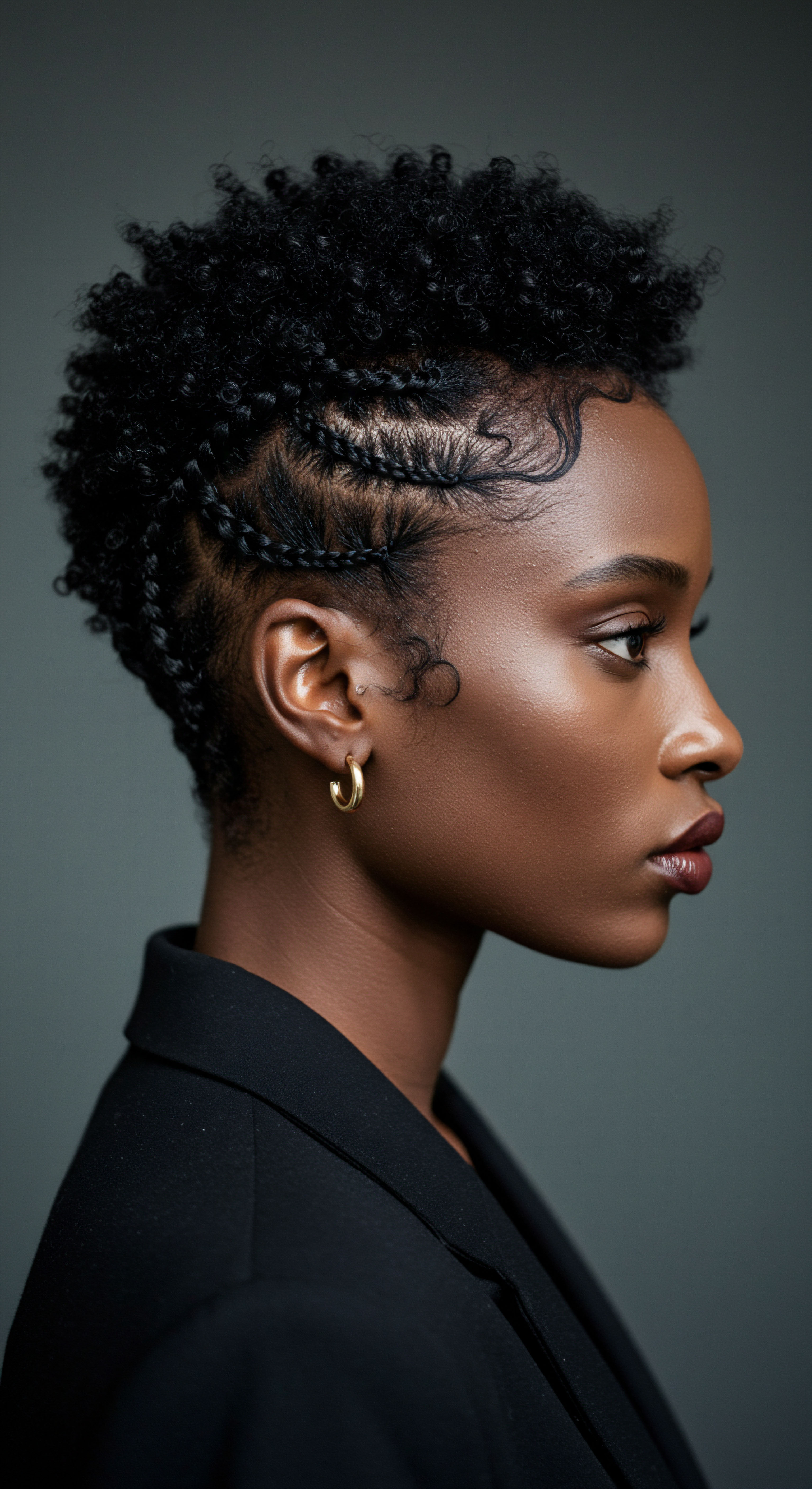
Roots
There exists a quiet language spoken by our strands, a narrative etched in the very helix of each hair. For generations, textured hair has held stories, carrying not only genetic whispers but also the imprints of care, of styling, and sometimes, of profound transformations. When we consider the application of chemical straighteners, our minds often turn first to the immediate visual shift, the sleek cascade, the altered curl pattern. Yet, the true inquiry beckons us deeper, beyond the visible alteration of the hair itself.
It asks us to consider the body as a vast, interconnected landscape, where every choice, every application, sends ripples far beyond its initial point of contact. This exploration begins at the very foundation, the intimate dance between the hair, the scalp, and the systemic pathways that lie beneath.
The hair strand, often perceived as inert, is a marvel of biological engineering, rooted within the dynamic environment of the scalp. The scalp itself, a living tissue, serves as a protective canopy, yet it is also a gateway. Understanding this fundamental relationship is paramount to comprehending how agents applied to our hair can extend their influence throughout the body.
Chemical straighteners, by their very nature, are designed to penetrate and alter the hair’s structure. This process, however, does not occur in isolation.

The Scalp’s Permeable Nature
The scalp, rich with blood vessels, nerve endings, and hair follicles, is a remarkably absorptive surface. Unlike the relatively robust skin on our palms or soles, the scalp is thinner and possesses a higher density of follicles, each a potential conduit into the body’s internal systems. When chemical straighteners are applied, they sit directly upon this sensitive skin, often for extended periods, allowing their active components ample opportunity for uptake. The heat sometimes applied during the straightening process can further enhance this absorption, opening the scalp’s pores and increasing the permeability of its outermost layers.
Consider the sheer volume of products applied to the scalp over a lifetime of hair care. While individual applications might seem minor, the cumulative effect of repeated exposure to certain compounds presents a different picture. The chemicals do not simply evaporate or rinse away entirely; a portion inevitably finds its way past the scalp barrier, entering the bloodstream and lymphatic system.

Hair’s Structure and Chemical Interaction
To understand the body’s response, one must first grasp the hair’s inherent composition. At its heart, hair is primarily composed of Keratin, a robust protein. The strength and texture of hair are determined by the arrangement of disulfide bonds within this keratin structure. Chemical straighteners operate by intentionally disrupting these bonds.
- Alkaline Relaxers ❉ These typically contain lye (sodium hydroxide) or no-lye alternatives (guanidine hydroxide, calcium hydroxide). They work by irreversibly breaking the disulfide bonds, softening the hair’s protein structure.
- Formaldehyde-Releasing Systems ❉ Often marketed as “keratin treatments,” these systems use compounds that release formaldehyde gas when heated. This gas forms temporary cross-links within the keratin, effectively stiffening and straightening the hair.
- Thio-Based Straighteners ❉ These use ammonium thioglycolate to break disulfide bonds, followed by a neutralizer to reform them in a straightened configuration.
Each of these chemical approaches, while differing in mechanism, shares a commonality ❉ they introduce potent agents onto the scalp and into the immediate environment of the hair follicle. The interaction is not confined to the hair shaft alone.
The scalp, a dynamic and absorptive surface, serves as an initial entry point for the potent chemical compounds found in hair straighteners, allowing their journey beyond the visible hair strand.

Initial Systemic Entry Pathways
Once these chemical agents breach the scalp barrier, they gain access to the body’s intricate network of circulation. The rich vascularization of the scalp means that substances absorbed there can quickly enter the bloodstream, circulating throughout the body. This is not merely a localized phenomenon; it represents a systemic exposure.
The lymphatic system, another vital circulatory network present in the scalp, also plays a role in transporting absorbed substances. These pathways serve as conduits, distributing the chemical components to various organs and tissues, where they can potentially exert effects far from the initial site of application. The speed and extent of this systemic entry depend on several factors, including the specific chemicals involved, their concentration, the duration of exposure, and the individual’s unique physiological responses.

Ritual
For many, the act of chemically straightening hair transcends mere styling; it is a ritual, a deeply ingrained practice passed down through generations, often connected to perceptions of beauty, professionalism, and social acceptance. This ritual, however, carries with it a hidden dialogue with the body, a conversation conducted through the very chemistry of the products used. As we move from the foundational understanding of absorption, our focus now shifts to the specific chemical components frequently found in these straighteners and their immediate, yet often overlooked, interactions with the body’s systems beyond the scalp. This segment aims to illuminate the silent exchanges that occur each time these potent formulas are applied.
The formulations of chemical straighteners are complex, often containing a blend of active agents, solvents, and conditioning ingredients. While the primary goal is hair alteration, the volatile nature of some components and the direct contact with skin introduce systemic considerations.

Understanding the Chemical Components
A deeper acquaintance with the chemicals commonly present in hair straighteners reveals the scope of potential bodily interactions. These are not inert substances; they are designed for reactivity, and that reactivity can extend beyond the hair shaft.
One prominent group includes Alkaline Agents, such as sodium hydroxide (lye) or guanidine hydroxide. These are highly corrosive substances, capable of causing chemical burns on contact with skin. While burns are often localized to the scalp, repeated or improper application can lead to chronic irritation, breaks in the skin barrier, and increased absorption.
Another significant category encompasses Formaldehyde-Releasing Chemicals. These are often found in “keratin treatments” or “Brazilian blowouts.” While formaldehyde itself might not be listed as an ingredient, compounds like methylene glycol, formalin, or methanal will release formaldehyde gas when heated. This gas is a known irritant and sensitizer.
Beyond the primary straightening agents, many formulations also contain a cocktail of other compounds, including various Preservatives, Fragrances, and Plasticizers, some of which have their own known systemic effects.

Respiratory System Responses
The air we breathe during the straightening process can become a conduit for chemical exposure. Products that release volatile organic compounds (VOCs), particularly those containing or releasing formaldehyde, pose a direct challenge to the respiratory system.
Symptoms can range from immediate discomfort to more serious, long-term concerns. Individuals, both those receiving and those applying the treatment, may experience ❉
- Eye Irritation ❉ Burning, tearing, redness.
- Nasal and Throat Irritation ❉ Soreness, coughing, sneezing, congestion.
- Respiratory Distress ❉ Shortness of breath, wheezing, exacerbation of asthma.
These symptoms are a direct consequence of inhaling the chemical fumes, which then interact with the delicate mucous membranes lining the respiratory tract. For individuals with pre-existing respiratory conditions, these exposures can be particularly challenging. The cumulative effect of repeated inhalation over years, especially for professional stylists, is a growing area of concern.

Beyond the Scalp Skin Absorption
While the scalp is the primary contact point, the hands of the stylist, the neck, ears, and even the shoulders of the individual receiving the treatment can be exposed. The skin, our largest organ, acts as a barrier, but it is not impenetrable. Prolonged contact with chemical straighteners on other skin surfaces can lead to localized irritation, dermatitis, and sensitization.
Moreover, systemic absorption can occur through these other skin areas, albeit typically at a lower rate than through the scalp. The chemicals can bypass the digestive system and liver’s first-pass metabolism, entering the bloodstream directly. This pathway contributes to the overall chemical burden on the body.
| Chemical Category Alkaline Agents |
| Common Examples Sodium Hydroxide, Guanidine Hydroxide |
| Immediate Systemic Interaction Skin irritation, chemical burns, potential for systemic absorption if barrier is compromised. |
| Chemical Category Formaldehyde-Releasing |
| Common Examples Methylene Glycol, Formalin |
| Immediate Systemic Interaction Respiratory tract irritation, eye irritation, sensitization through inhalation. |
| Chemical Category Thio Compounds |
| Common Examples Ammonium Thioglycolate |
| Immediate Systemic Interaction Skin irritation, potential for systemic absorption and allergic reactions. |
| Chemical Category Phthalates |
| Common Examples Dibutyl Phthalate (DBP), Diethyl Phthalate (DEP) |
| Immediate Systemic Interaction Often used in fragrances, potential for skin absorption, respiratory irritation. |
| Chemical Category These interactions represent the immediate effects of chemical exposure, signaling a broader systemic dialogue. |
The volatile compounds within chemical straighteners can directly irritate the respiratory system upon inhalation and contribute to systemic chemical absorption through contact with various skin surfaces.
The cumulative effect of these seemingly minor exposures, particularly when repeated over many years, prompts a deeper inquiry into the body’s long-term responses. The initial irritations and absorptions are but the first notes in a complex biological composition.

Relay
To consider the full breadth of chemical hair straighteners’ influence requires us to move beyond the immediate sensations and visible alterations, inviting us into a deeper, more interconnected understanding of the body’s subtle, yet profound, responses. What happens when these chemical agents, absorbed through the scalp and inhaled into the lungs, begin their quiet circulation through the body’s intricate systems? This section seeks to unravel the complex dialogue between these compounds and our internal landscapes, drawing on research and insights that bridge the gap between beauty practices and long-term well-being. It is here that the interplay of biological science, societal pressures, and personal narratives truly converges.
The body is a symphony of finely tuned systems, each reliant on delicate balances. When exogenous compounds, particularly those with reactive properties, enter this internal environment, they can disrupt these balances, sometimes in ways that only become apparent over extended periods.

Can Hair Straighteners Affect Hormonal Balance?
One of the most compelling areas of concern revolves around the endocrine system, the body’s network of glands that produce and release hormones. Hormones are the chemical messengers that regulate nearly every physiological process, from metabolism and growth to mood and reproduction. Certain chemicals found in hair straighteners are classified as Endocrine-Disrupting Chemicals (EDCs). These EDCs can mimic, block, or interfere with the body’s natural hormones, potentially leading to a cascade of downstream effects.
Phthalates, often present in fragrances and as plasticizers in various cosmetic products, are a well-documented class of EDCs. Studies suggest that exposure to phthalates can interfere with estrogen and androgen pathways, potentially impacting reproductive health in both women and men. Similarly, some parabens, used as preservatives, have shown weak estrogenic activity, meaning they can bind to estrogen receptors in the body. While the individual exposure from a single product might seem small, the cumulative exposure from multiple sources over time raises questions about their collective impact on hormonal equilibrium.
The implications of endocrine disruption are wide-ranging, affecting not only reproductive organs but also thyroid function, metabolic regulation, and even neurological development. The body’s ability to maintain its hormonal rhythm is paramount for overall health, and persistent interference from external chemicals can set the stage for chronic conditions.

What are the Links to Reproductive Health Concerns?
The connection between chemical hair straighteners and reproductive health has garnered significant scientific attention, particularly concerning women. A landmark study published in the Journal of the National Cancer Institute in 2022, part of the Sister Study by the National Institute of Environmental Health Sciences (NIEHS), provided compelling data on this link. The research found that women who reported frequent use of hair straightening products, defined as using them more than four times in the previous year, were more than twice as likely to develop Uterine Cancer compared to those who never used them.
This finding is particularly striking because uterine cancer incidence rates have been rising in the United States, especially among Black women. The study’s design allowed for careful consideration of other factors, strengthening the observed association.
Beyond uterine cancer, other research points to potential associations with uterine fibroids, which are non-cancerous growths in the uterus but can cause significant pain, heavy bleeding, and fertility issues. While the exact mechanisms are still being explored, the endocrine-disrupting properties of some straightener components are suspected to play a role in the development or exacerbation of these conditions. The female reproductive system, with its complex hormonal regulation, appears particularly vulnerable to such chemical interferences.

Immune System and Systemic Inflammation
The body’s immune system is a sophisticated defense network. When chemical irritants are absorbed or inhaled, they can trigger immune responses. While acute reactions might manifest as skin irritation or respiratory symptoms, chronic exposure can lead to a state of low-grade systemic inflammation. Persistent inflammation is increasingly recognized as a contributing factor to a wide array of chronic diseases, including autoimmune conditions, cardiovascular disease, and certain cancers.
Some individuals may also develop chemical sensitivities or allergies over time, where even minor exposure to a particular ingredient can elicit a disproportionate immune reaction. This sensitization is a systemic phenomenon, meaning the body’s immune memory is altered, and subsequent exposures, even if not directly on the scalp, can trigger a response.

Cancer Risk Considerations
The uterine cancer study mentioned earlier is a significant piece of the puzzle, but research continues to investigate other potential cancer links. The presence of formaldehyde-releasing chemicals is a major concern, as formaldehyde is classified as a human carcinogen by the International Agency for Research on Cancer (IARC). Prolonged or repeated exposure to carcinogens, even at low levels, can increase the risk of cellular changes that may eventually lead to cancer.
Beyond uterine cancer, some studies have explored potential links to breast cancer, particularly in specific populations or with certain types of hair product use. While the evidence is still accumulating and often complex, the consistent theme is the presence of chemicals known or suspected to be carcinogens or endocrine disruptors within these formulations. The body’s detoxification pathways work tirelessly, but they can become overwhelmed by chronic exposure, allowing harmful compounds to persist and potentially cause damage at a cellular level.
Research indicates that frequent use of chemical hair straighteners may elevate the risk of uterine cancer and contribute to hormonal imbalances, highlighting systemic health concerns beyond the scalp.

The Societal Echo of Straightening
To fully grasp the implications of chemical straighteners on the body, one must also acknowledge the profound cultural and societal context that has driven their widespread use, particularly within Black communities. For generations, straightened hair has been intertwined with concepts of acceptability, professionalism, and beauty standards largely shaped by Eurocentric ideals. This pressure often began in childhood, leading to early and prolonged exposure to these chemicals.
The decision to straighten hair was, and for many still is, not merely a cosmetic choice but a complex negotiation of identity, belonging, and perceived opportunity. This historical and ongoing context means that discussions about the health effects of straighteners are not just about individual chemical exposure; they are about systemic inequalities and the impact of beauty norms on well-being. Recognizing this cultural dimension adds a vital layer of understanding to the biological data, underscoring the importance of holistic wellness that encompasses both physical and emotional health.

Reflection
Our exploration into the quiet journey of chemical hair straighteners through the body reveals a landscape far more intricate than surface appearances suggest. From the permeable pathways of the scalp to the nuanced dance with our hormonal and immune systems, the dialogue between product and physiology is continuous. This understanding invites us to pause, to consider the choices we make for our hair not in isolation, but as threads woven into the broader tapestry of our overall well-being.
It encourages a gentle curiosity about the substances we invite into our personal space and a deeper respect for the body’s remarkable, yet sometimes vulnerable, internal workings. As we move forward, may our knowledge be a grounding presence, guiding us toward practices that honor both the beauty of our textured strands and the profound vitality of our entire being.

References
- Chang, C. J. et al. (2022). Use of Hair Straightening Products and Incident Uterine Cancer. Journal of the National Cancer Institute, 114(12), 1636–1642.
- Environmental Working Group. (2020). The Toxic Twelve ❉ Chemicals and Contaminants in Cosmetics.
- Hrubec, T. C. et al. (2015). Hair Relaxer Use and Breast Cancer Risk in the Black Women’s Health Study. Environmental Health Perspectives, 123(12), 1272–1278.
- National Institute of Environmental Health Sciences. (2023). Hair Relaxers and Cancer Risk. NIH Publication.
- Thyssen, J. P. & Maibach, H. I. (2018). Hair Dyes and Hair Relaxers ❉ Allergic Contact Dermatitis. CRC Press.
- Zota, A. R. et al. (2017). Personal Care Product Use and Urinary Concentrations of Phthalate Metabolites in the National Health and Nutrition Examination Survey (NHANES) 2003–2010. Environmental Health Perspectives, 125(10), 107005.